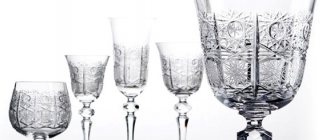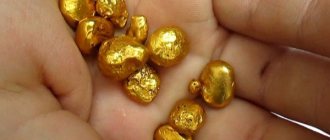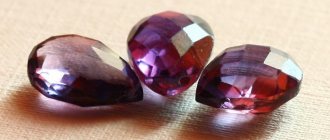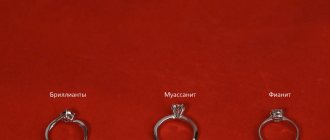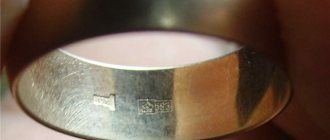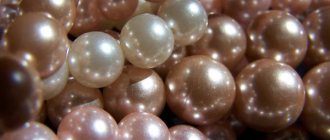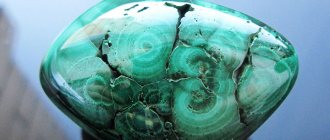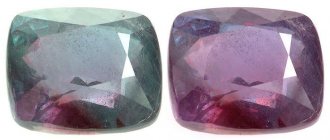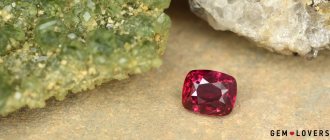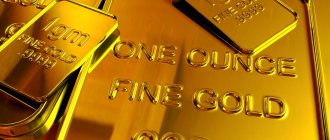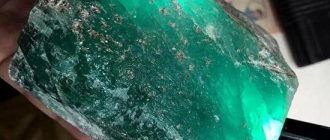Good afternoon dear friends! Our article today is dedicated to aventurine - the ruler of the souls of fashionistas and fashionistas of past centuries. They say that Queen Cleopatra and her lover Julius Caesar admired him. However, despite its advanced age by human standards, this stone still delights us with its beauty and grace. It is its enchanting unearthly beauty that makes dishonest people look for an opportunity to imitate it. We will talk further about how to distinguish aventurine from a fake.
Getting to know the uniqueness of the mineral
So, what is aventurine and what does it look like? Aventurine is a rock formed by fine-grained quartzite with inclusions of flakes of goethite, hematite, as well as micas such as biotite, muscovite and fuchsite. It is thanks to them that aventurine looks like the starry sky of a planet unknown to us.
If you ask why unknown, we will answer that:
- The color of aventurine ranges from greenish blue to chocolate brown. Agree, our sky is different from the colors stated here.
- Another recognizable feature of aventurine is its cluster of scales, similar to star clusters such as Messier 7 or Touca. It is this extraterrestrial shine that artisans of all stripes and ranks are trying to reproduce.
HEALING AND MAGICAL PROPERTIES
Blue aventurine stone is credited with many medicinal properties.
It is believed to help with:
- skin diseases (eczema, warts, baldness, allergic rashes);
- bronchitis, colds, tonsillitis;
- diseases of the cardiovascular system;
- depression.
It is believed that the blue gem helps to get rid of causeless fear, apprehension and all kinds of phobias.
Lithotherapists suggest using blue aventurine as a general tonic and preventative.
Its deep blue color has a beneficial effect on vision, relieving fatigue, and relaxing muscles during evening meditation. If you consider the dim flicker of aventurine, you can imagine plunging into the depths of the universe. As a result, complete relaxation occurs - spiritual and physical, and fatigue goes away.
Magicians claim that a blue gem can also influence character. For example, it can calm a very impulsive person, awaken good nature in an aggressive person, and give self-confidence to an indecisive person. It will help everyone, without exception, on the road or travel.
We recommend: CHAROIT - the treasure of Siberia, “lilac stone”
Another magical property of blue aventurine, like many other gems, is protection from the evil eye and damage, gossip and intrigue, in a word - energy protection. This is explained by the reflective surface of the stone.
When combined with pearls, the gem prolongs life, and when combined with emerald, it enhances sexual desire.
Learning to distinguish aventurine from a fake
Much water has passed under the bridge since then. But attempts to create an artificial analogue of aventurine do not stop. How to distinguish a fake from the original? To do this, we need to remember several constants that determine genuine aventurine.
- The first constant is shine. If the sample offered to you has a very high concentration of blisters, you can say with 99.9% confidence that it is a fake. To create it, so-called “aventurine glass” is used. During its manufacture, small particles of copper, chromium, iron and cobalt are placed into the molten glass mass. They, in addition to directly creating a stellar shine, also participate in giving the glass the color required by the glassmaker. For example, copper gives glass a reddish tint, iron gives it a brownish tint, chromium gives it a greenish tint, and cobalt gives it a deep blue tint.
If you make a complex introduction of these metals, the effect will be stunning! We will see glass that looks no different from natural stone. However, a real connoisseur will immediately understand that this is a fake. If you also want to gain the knowledge of an expert, then…
- The second constant is the gloss density. In natural aventurine, the sparkles are unevenly spaced. This is due to the fact that aventurine, being a natural stone, has a granular structure. The flashing elements are located in the intergranular space and cannot be distributed evenly.
As for glass, as you probably remember from your school physics course, it has an amorphous structure, as a result of which particles can accumulate locally where the glassmaker needs it. To do this, you only need to make a few movements, driving the particles into the required area.
- The third constant is the form of blisters (glitters). If you look at aventurine glass through a magnifying glass, you will notice the geometric similarity of each element. Most often this is:
- triangle;
- hexagon;
- circle.
If we talk about real aventurine, then, as a rule, the particles in it have different shapes and glow strengths. This is due to the fact that genuine shine is created by several types of blisters at once. (We remind you: we call inclusions of various types of mica, as well as small crystals of goethite and hematite, blisters).
- The fourth constant is hardness. To find it out, we will have to use the Mohs geological hardness scale. Thanks to it, you can easily determine the approximate affiliation of a mineral to a particular group. The scale is conventionally divided into 10 classes (degrees) of hardness. At the same time, talc, used as powders and additives to tablets, occupies 1st place in it. Diamond, as the hardest mineral on our planet, represents class 10 on the Mohs scale.
But let's return to aventurine. It is confidently located in the hardness zone 7. Glass, on the other hand, occupies only 5th position in this scale. In other words, the hardness of genuine aventurine is 2 orders of magnitude higher than that of aventurine glass.
Now let's talk about what these hardness numbers give us. If we have natural aventurine and its artificial counterpart in brilliance, we can conduct the following experiment. Let's take a stone and try to draw a line with it on the surface of aventurine glass. The line will be clear and obvious. Glass will not leave any marks on the surface of the mineral. If we do not have genuine aventurine, and it is necessary to verify the authenticity of the proposed sample, we can use minerals that have the same degree of hardness as aventurine. This is primarily quartz (rock crystal), as well as garnet and tourmaline.
LEGENDS AND MYTHS ABOUT BLUE AVENTURINE
Beliefs about dark blue aventurine are quite contradictory. According to some, the gem brings good luck to gambling people, gamblers, risky businessmen - in a word, adventurers (in the good sense of the word). Others believe that a blue stone with iridescent sparkles will bring love to its owner, clear the mind and enhance positive emotions, and give self-confidence.
Actually, one does not interfere with the other - you can be a risky entrepreneur, have a clear head, love and be loved. Or, for example, work as a rescuer, constantly risking your life - which is impossible without self-confidence.
Aventurine
Reasons for imitations
Unfortunately, gone are the days when it was possible to discover a treasured gemstone on a simple path. But the population of our planet is increasing. And along with him, his need for the “star stone” grows. The mineral is used to create jewelry such as brooches, beads, earrings, rings, and pendants. More massive objects of art are not currently produced from this mineral. This is due to the fact that this stone is rarely found in the form of large formations (a formation is considered large if its dimensions are at least half a meter in diameter).
Interesting fact
In the 18th century, aventurine was discovered on the territory of the Southern Urals, the dimensions of which made it possible to carve three vases from it, each of which was 146 cm high and 246 cm wide. One of these vases is still in the State Hermitage Museum (city) . Saint Petersburg).
What to choose: aventurine or aventurine glass
If you set out to purchase jewelry made from real aventurine, you should be prepared for the following:
- its color will not be bright (most often aventurines have a weak color of the grains);
- blisters of natural aventurine are located unevenly in space and differ in the degree of gloss;
- large formations of aventurine are rare, and, therefore, the price of products made from it is high.
Now regarding aventurine glass. Although it is a counterfeit of aventurine, it also has its advantages:
- The first plus is the price. Compared to the cost of natural aventurine, the cost of its analogue is relatively low.
- The second plus is the color scheme. Thanks to modern advances in glassmaking, the creators of aventurine glass can give it any color required by the customer.
- Plus the third is the brightness of the shine. If you want to get a piece of jewelry that resembles the light of distant stars, you should also consider aventurine glass. The fact is that in the original the sparkles are scattered chaotically and rarely form “star” clusters.
- Plus the fourth one is size. Due to the low cost of star glass and the ease of its processing, you can order products from manufacturers, the size of which is limited only by the capabilities of your wallet. This could be a perfume bottle for your beloved woman or a life-size statue of yourself. It's up to you to choose.
FEATURES OF BLUE MINERAL
Blue aventurine is an opaque mineral, highly polished, hardness – 7, density – 2.5. Its deposits are found in Western Europe, India, the USA, and Australia. In Russia - in the Urals.
The price per gram of blue aventurine is very low - cabochons from it cost between 100-200 rubles, a set of rings and earrings in silver - about 1200-1500, a bracelet - 1400, beads - 1600 rubles. Interestingly, artificial blue aventurine is valued three times more expensive.
Any minerals require cleaning, and blue aventurine is no exception, so there are certain care rules:
- Periodically, products with blue aventurine should be washed in soapy warm water with a soft sponge;
- the use of abrasive and chemical agents is strictly prohibited;
- It is recommended to sometimes expose blue aventurine to the sun for energy recharging;
- It is better to store it in a box with soft upholstery on the inside.
We recommend: BLACK STONE MORION
In addition, jewelry with this aventurine must be “walked” - the mineral will lose its properties if you forget about care.
Authentication
Aventurine glass and method for its production
, REPUBLIC YAO 907 A TsS 03 C 3/04 USSR STATE COMMITTEE FOR INVENTIONS AND DISCOVERIES DESCRIPTION OF THE INVENTED TORSO TH region of the color spectrum, R 20 laughs at the components of transmission in the visible spectrum and expansion, it is additionally related to the following relationship.
%:(71) Moscow Order of Lenin of Labor Red Banner Technological Institute Imdeleev(,57) 1. AVANTURINE GLASS 6 01, 9 a O, CaO, A 60 differ in order to reduce the duration of heat treatment, increase Prgo2. Method of obtaining glass by boiling under temperature conditions, first, subsequent inertia to room temperature and temperature cooling is carried out at a speed of 100-2000. Synergistic cooling is carried out by heating to 800 and holding at this temperature for 0.5-1.0 hours. 55 ,3-65.017.0-25.54.,2-12.50.1-2.03.5-8.00.1″5.0 vanturine recovery refrigeration cooling system, about that before 480-510 C min, and the front glass under RF 50 C with a high temperature in the current The invention relates to the field of glassmaking, namely to compositions and methods for producing avatyurine glasses, and can be used for the production of jewelry, decorative art items and facing materials. Aventurine glass is known, including, weight. At:50. 55 UZ m,o 4.1-6.4Сао 16-20.5мого.е 0 0.5-1.8ago 0.5-5.5SG, 0 3.3-8.0.Р 20 0.5- .3.5 and, in addition, the coloring additive Cao 2.0-4, OGeo 2.0-6.5 MPO 2.6-6.8 Glass has a melting temperature of 1440-1460 C, heat treatment 1320-1360 C, beginning of softening 750-770 C, color - green, blue, yellow or pink - depending on the type of coloring additive. However, this glass has practically zero light transmission in the visible region of the spectrum and a long cooking and production time. The closest to the proposed one in terms of technical essence and the achieved result is aventurine glass 2, including , weight. b:, 2.13 Glass is prepared as follows: The charge is loaded into pots at high temperature, it is boiled for at least 1.5 hours, and 1 hour before the end of cooking, a reducing agent is added to the glass mass, thoroughly mixed until opaque glass is obtained. After boiling, the glass mass is cooled to 900 C for 2.5 hours, then close the furnace and cool the glass together with the furnace to 200 C for 27-29 hours. Then the glass is cooled to room temperature, the pots are dismantled and the best pieces of aventurine glass are selected. The glass has a heat treatment temperature of 500-900 C, is opaque, has reflection brown. color with sparkles. The disadvantage of this glass is low manufacturability, low light transmittance, long heat treatment time: 65 The purpose of the invention is to reduce the duration of heat treatment, increase light transmission in the visible region of the spectrum and expand the color gamut.5 This goal is achieved by the fact that aventurine glass, including YaO, Mago, Cao , AChO, SOO additionally contains PO in the following ratio of components, 10 wt. В:,о 0.1-2, 015 Sio 3.5-8.0Р 20% 0.1-5.0 According to the method of producing aventurine glass by melting it under reducing conditions, primary cooling, subsequent inertial cooling to room temperature, primary cooling is carried out up to 480-51 0 C at a rate of 100-20000 C/min with holding at this temperature for 1.5 hours before inertial cooling, the glass is heated to 800-850 fC with holding at this temperature for 0.5-1.0 hours. The obtained glass has a light transmittance of 34-6 RH, a cooking temperature of 1250-1400 C, heat treatment of 800-850 C, heat treatment time of 0.5-1.0 hours, cooling rate of 100-2000 C/min, transparent in appearance and colorless or slightly pink or bluish color, have golden sparkles in the mass. Table 1 shows the compositions of aventurine glass. EXAMPLE 1, Michtu table 1, composition Prepared using conventional technology: raw materials are first sifted through a sieve of 144 holes/cm, then component "You are weighed in the required quantities45 and mixed. Glass melting is carried out in fireclay crucibles with a capacity of 0.5 l, Cooking temperature 1300 C, exposure at maximum temperature for 1 hour, medium in the furnace 50 degrees 6 o reducing, Production is carried out from the cooking temperature by free casting in metal molds size 5050 5 mm . The produced products55 are annealed for 2 hours at 4800 C and then subjected to additional heat treatment at 850 C for 1 hour. The heat-treated glass is transparent, has a slight yellowish tint and is evenly permeated throughout the entire volume with golden sparkles up to 130 microns in size. Example 2, fir for composition 2 (Table 1) is prepared similarly to example 1. Glass production is similar. The 9 products produced are subjected to heat treatment at 300 C for 45 minutes. The glass is transparent, almost colorless and golden sparkles with a size of 100-120 microns are scattered throughout the entire volume. EXAMPLE 3. Technology for producing glass of composition 3 (Table 1 ) is similar to example 1. The glass is boiled at 1250 °C, held for 1 hour. The medium in the furnace is weakly reducing. Heat treatment is carried out at 820 °C for 0.5 h. The glass is transparent, has a turquoise tint and contains glitter throughout its entire volume up to 150 microns in size .Example 4. The technology for producing glass of composition 4 of Table 1) is similar to example 1. Loading the mixture and cooking. produced at 1350 °C, holding time for 1 hour. Production is carried out by manual rolling with a metal shaft of 100 mm on a metal plate. The cooling rate under these conditions is 2000 C/min. The glass is annealed in a muffle furnace at 510 C for 1.5 hours, subjected to additional heat treatment at 850 C for 1 hour and cooled. Table 2 shows the properties of known and proposed aventurine glass . A distinctive feature of the proposed aventurine. glass is transparent in the visible region of the spectrum. Light transmission 35-65 5U (Table 2). The well-known aventurine glass has zero light transmission. The aventurine effect is achieved by saturating the silicate melt with 10 copper, which crystallizes during cooling in the form of sparkles. In the production of aventurine glass of the proposed composition for the manufacture of jewelry, the cost of 1 ton of reactant, calculated for 15-15 tons of glass mass, will be 116 53 rubles at this time, as for the well-known composition of aventurine glass, the value of 156.53 rubles. The economic efficiency of using the new composition when producing 200 tons of glass per year will be 8,000 rubles. The resulting aventurine glass, having a beautiful appearance, can be used in the production of jewelry, decorative and artistic items, as well as facing materials. Transparency in the visible region of the spectrum when using colored substrates will significantly expand the scope of its application. 1058907 Table 2 Glass composition Properties 1 .2 .3 4 Prototype Melting temperature, cC, 1300 1300 1300 1250 1350 Cooling rate, C/min 500 100 1000 2000850 800 820 850 1.0 1.0 075 0.5 Brown, sparkles Light transmission, b 65.5 52 48 Compiled by G, Burovgeva Editor L. Veselovskaya Technical editor M. Nagy Corrector S, Yekmar Order 9697/20 Circulation 486 Subscribed VNIIPI of the State Committee of the USSR by Affairs of inventions and discoveries 113035, Moscow, Zh, Raushskaya nab., 4/5 Branch of PPP: Patent, Uzhgorod, Proektnaya str., 4 Heat treatment temperature, Heat treatment time, h Appearance of glass Transparent yellowish-yellowish sparkles Transparent cancerous colorless” color-. noe. new, glitter-spangles transparent blue- bluish sparkles 0.45″2.66900-20027-29 View
